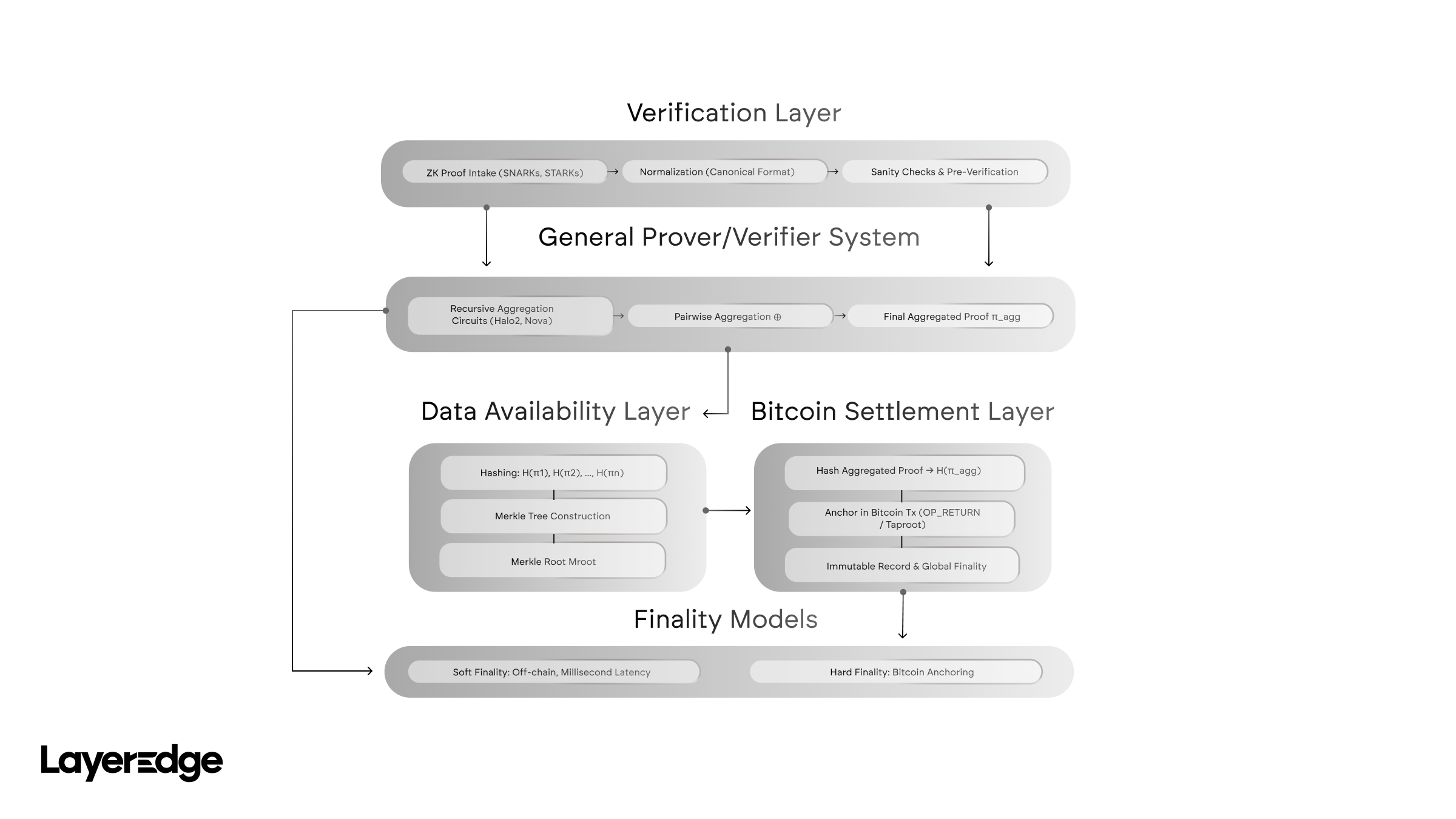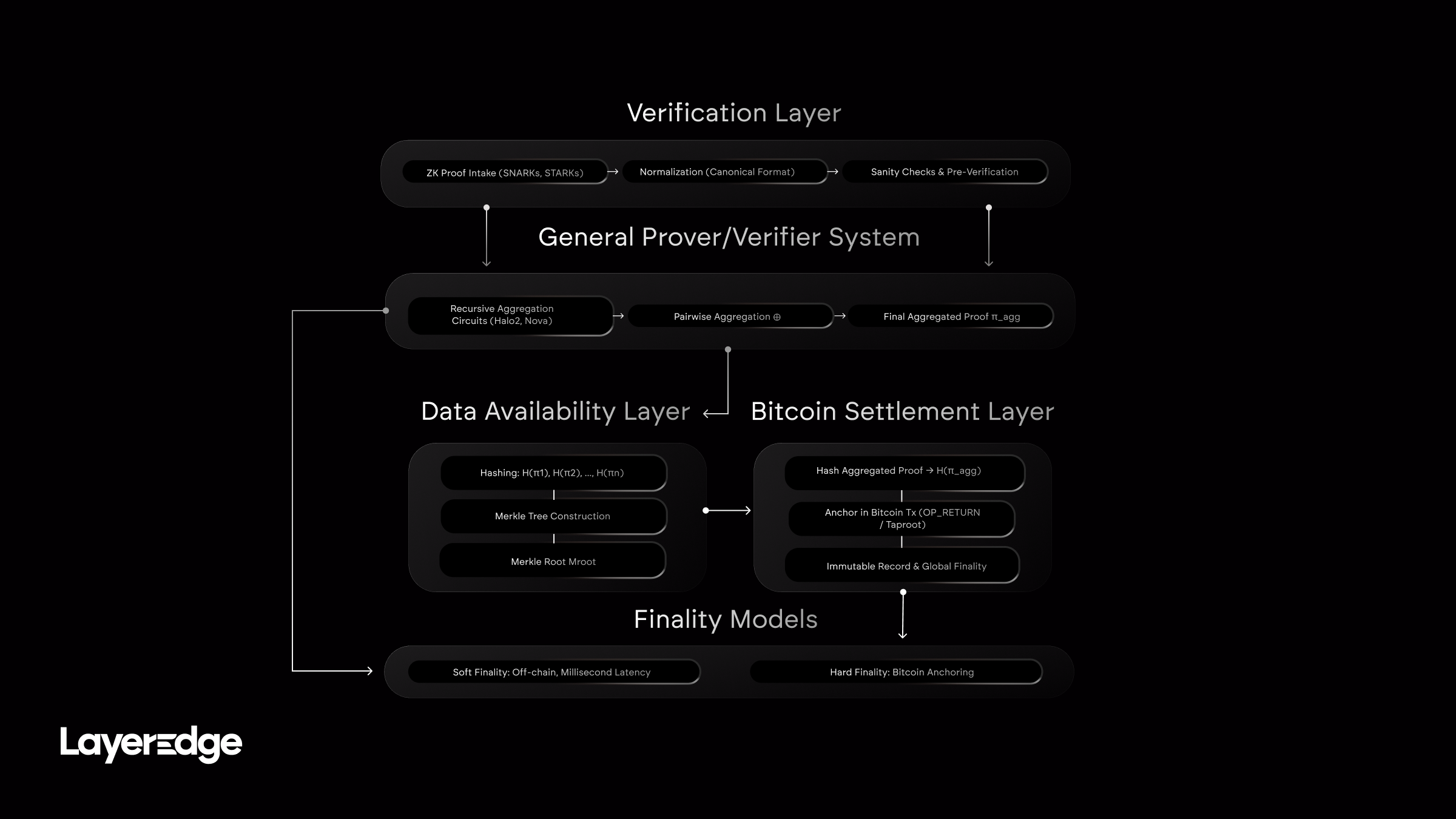Architecture
Introduction: Bitcoin Backed Internet
LayerEdge transforms Bitcoin from a passive store of value into a verifiable infrastructure layer for off-chain computation. At the center of this transformation is the Proof Aggregation Layer — a modular system that enables recursive zk-proof verification across protocols, applications, and data pipelines, with finality rooted in Bitcoin's Proof-of-Work (PoW).
This system allows:
- Thousands or millions of zk-proofs to be recursively compressed into a single succinct proof
- The result to be anchored on Bitcoin in a tamper-proof, cost-efficient way
- Developers to scale verifiable computation without overwhelming Bitcoin L1
It is designed to serve as the universal verifier layer for blockchains, rollups, zkML, decentralized AI, and off-chain infrastructure.


What It Does
The Proof Aggregation Layer is responsible for:
- Accepting zk-proofs from heterogeneous systems
- Normalizing and batching these proofs
- Recursively aggregating them into one succinct proof
- Anchoring that final proof to Bitcoin
- Ensuring the entire flow is cryptographically verifiable and publicly auditable
This process allows:
- A rollup to verify 1,000 blocks with 1 proof
- An AI model to validate 10,000 inference steps off-chain
- An L2 chain to settle its entire epoch using one zk anchor
- And all of that to be verifiably tied to Bitcoin
Supported Proof Systems
LayerEdge is designed to be proof-system agnostic, supporting a wide spectrum of zk-proving technologies:
SNARKs
- Groth16
- PLONK
- Halo2
- Nova
- Plonky2
STARKs
- AirSTARK
- Fractal
- RISC Zero
- SP1
zkVMs & Hybrid Runtimes
- Nexus
- Modular zkVM chains that output verifiable computation
These proofs are passed to the Verification Layer, where they are normalized and formatted into a unified intermediate representation.
Recursive Proof Aggregation
Concept
Rather than verifying every zk-proof one by one, LayerEdge uses recursive composition to combine all proofs into a single final proof , which attests to the correctness of all constituent proofs.
This drastically reduces:
- Computation load
- On-chain gas cost
- Storage overhead
- Verification time
How It Works (Step-by-Step)
-
Proof Generation Protocols generate zk-proofs for off-chain computations (e.g. L2 state transitions, ML inference, data attestations).
-
Proof Submission These proofs are submitted to the Verification Layer, along with metadata.
-
Normalization All incoming proofs are transformed into a standard internal representation, regardless of their zk framework.
-
Recursive Aggregation A cryptographic engine (e.g., Halo2, Nova, Spartan) aggregates the proofs recursively using a tree structure:
- First merges pairs of proofs
- Then merges those merged proofs
- Continues until a single πagg remains
-
Finalization & Anchoring The final succinct proof is committed via DA layer + Bitcoin anchoring
Technical Benefits
| Feature | Benefit |
|---|---|
| Logarithmic Verification | Verifier checks only 1 proof regardless of batch size |
| Low On-chain Cost | Aggregated proofs reduce Bitcoin footprint by >95% |
| Multi-Proof Compatibility | Supports Groth16, Halo2, RISC Zero, Nexus, etc. |
| Auditability | All original proofs retrievable via DA Merkle paths |
| PoW Anchored | Final proof verifiability inherits Bitcoin's consensus security |
Performance Comparison
| Property | Individual Proofs | LayerEdge Aggregation |
|---|---|---|
| Number of Proofs | 10,000 | 1 |
| Verifier Time | O(n) | O(log n) |
| Proof Size | Large (n × proof) | Small (single proof) |
| Bitcoin Settlement | High (per proof tx) | Minimal (1 tx) |
| Cost per Protocol | $900+ | <$20 in 50-protocol network |
| Storage Overhead | High | Compressed + Merkle root |
Architecture: The Four Core Modules
The Proof Aggregation Layer ties together four core architectural systems in LayerEdge:
1. Verification Layer
- Accepts proofs from all zk frameworks
- Normalizes inputs for the aggregation engine
- Performs initial validation and metadata capture
2. General Prover / Verifier System
- Aggregates normalized proofs recursively
- Uses proof-friendly circuits (Halo2, Nova, Plonky3)
- Produces a final aggregated zk-proof
3. Data Availability Layer (DA)
- Commits each zk-proof's hash in a Merkle tree
- Stores root on LayerEdge BSN for auditability
- Allows light clients to verify Merkle Tree efficiently
4. Bitcoin Anchoring
- Anchors on Bitcoin using:
- OP_RETURN (hash-only)
- Taproot scripts (commitments only)
- OP_CAT (Onchain Verification)
- Inherits finality from Bitcoin's PoW consensus
Why This Design Works
LayerEdge doesn't force Bitcoin to compute — it lets Bitcoin verify.
The aggregation layer enables the system to:
- Keep computation off-chain
- Keep verification trustless
- Keep finality secure and immutable
In doing so, it solves the scalability bottleneck for any zk-based system that wants to root its trust model in Bitcoin.
Real-World Applications
| Use Case | Benefit of Aggregation |
|---|---|
| Rollups & L2s | Compress block transitions into a single proof |
| zkML / AI | Aggregate multiple inference steps |
| IoT / DePIN | Verify distributed sensor data |
| zkOracles | Compress multiple feeds / queries |
| Decentralized Identity | Aggregate credential validations |
| Multichain Settlements | Batch proofs from L1s/L2s into a single zk-settlement |
Anchored Finality
The final proof πagg is:
- Committed to LayerEdge's Data Availability chain
- Anchored on Bitcoin for finality
- Auditable by any light client using inclusion proofs
This creates a system where:
- Light clients can verify that their data was included
- Protocols can build trustless zk-rollups with Bitcoin settlement
- Auditors can confirm zk-proof correctness without re-execution
Related Subpages
LayerEdge is composed of five core architectural modules, each addressing a distinct aspect of secure, scalable, and verifiable computation. This section delves into the intricate technical details of how these components interact and ensures seamless end-to-end functionality.
📄 Verification Layer
Learn more about LayerEdge's Verification Layer
📄 General Prover / Verifier System
Learn more about General Prover / Verifier System
📄 Data Availability Layer
Learn more about how underlying proofs remain publicly verifiable
📄 Bitcoin Anchoring
Read more about how the final aggregated proof is anchored on Bitcoin
📄 Built on Babylon
Learn more about how Babylon is integrated with LayerEdge
Conclusion
The Proof Aggregation Layer is the backbone of the LayerEdge. It enables:
- Massive zk scalability
- Verifiable off-chain execution
- Modular zk infrastructure
- And finality secured by Bitcoin
By compressing thousands of zk-proofs into a single anchorable proof, LayerEdge turns Bitcoin into a global proof-of-verification engine — ready to secure the next generation of decentralized computation.